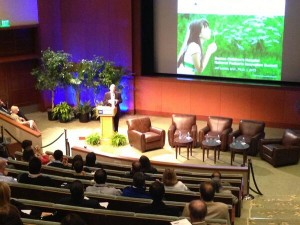
Vertex Pharmaceuticals CEO Jeffrey Leiden, MD, PhD, at Boston Children’s Hospital’s National Pediatric Innovation Summit + Awards 2013. (Courtesy Vertex Pharmaceuticals)
“I can’t imagine a better time to have an innovation summit in pediatric medicine. We’ve reached a tipping point in pediatrics medicine with scientific innovations converging to completely change the way we think about and treat pediatric disease,” Jeffrey Leiden, MD, PhD, president and CEO of Vertex, shared during the opening keynote at Boston Children’s Hospital’s National Pediatric Innovation Summit + Awards 2013.
The genesis for many of these innovations was the Human Genome Project, which unveiled some 5,000 additional genes that provide potential new drug targets. DNA sequencing followed, and its price and rapidity continue to improve. “In two to three years, children will be sequenced in one day at birth at a cost of $200-$300. We’ll know their risk for disease, and will be able to treat children to cure or prevent [adult diseases like diabetes],” predicted Leiden.
The way physicians treat disease also will change. Stem cell biology to repair and replace damaged organs will emerge in pediatric disease in three to five years, he continued. Other promising developments in the pipeline include cellular and nucleic acid therapies to repair or replace abnormal proteins in genetic and infectious diseases, as well as gene editing to correct abnormal genes as a curative therapy. In the next decade, these will be possible in vivo, said Leiden.
Peering into the future, looking back
Leiden offered four predictions for 2020. These are:
- People will know their DNA sequence and risk of disease from birth, marking the era of preventive medicine.
- Medicine will cure or prevent disease as opposed to treating symptoms of disease.
- Diagnostics, devices and medicines will be developed together to target the treatment of serious diseases.
- Patients and physicians will be rapidly and continuously informed as decision makers.
Cystic fibrosis, said Leiden, may provide a prime example in the innovation revolution in pediatric medicine. Key stakeholders―academic investigators, companies, patients and their families and the philanthropy group, Cystic Fibrosis Foundation―formed a partnership, with the foundation funneling capital into research and development of new medicines. Thus, innovation comprised both scientific and partnership strategies produced a new pharmacological treatment for the disease.
The establishment of dedicated cystic fibrosis treatment centers at 300 sites in the United States, and the genotyping of all children with cystic fibrosis in 1990s served as important stepping stones in the pipeline process.
The discovery of the CFTR (cystic fibrosis transmembrane conductance regulator) gene marked a critical juncture. Mutations in the gene cause cystic fibrosis. Initially, researchers were discouraged, recalled Leiden, as they realized more than 1,900 different mutations caused the disease and these caused different types of cystic fibrosis.
This immense challenge became more manageable as researchers observed that the majority of mutations could be bucketed into two primary categories: quantity and function. Quantity mutations occur when the protein doesn’t fold properly and doesn’t reach the surface of the cell, while function mutations are properly folded proteins that reach the surface of the cell but need to be opened to function correctly. Thus, two different types of medicine were needed.
Vertex first focused on the function problem, which affects approximately 15 percent of patients, and developed a human cell-based screen using cells from patients with cystic fibrosis and leveraged the cellular biology experiment to develop the drug KalydecoTM. A Phase 3 clinical trial showed rapid and sustained improvement in lung function over 60 weeks.
By 2012, Vertex submitted Kalydeco to the FDA, which approved the drug in less than three months. Within nine months, 90 percent of eligible patients were taking Kalydeco.
The 23-year process from discovery of the CTFR gene in 1989 to FDA approval will be cut to eight to 10 years in the future through a stronger innovation ecosystem, predicted Leiden.
Vertex continues to build on this initial innovation to develop additional new treatments to target quantity mutations in patients with cystic fibrosis. The company used the same cell-based screening process to devise a two-drug combination of corrector and potentiator treatments for these patients, which are currently in Phase 3 trials. This could treat another 50 percent of patients with cystic fibrosis, if the trial results prove positive.
Finally, the company has devised a three-drug therapy that aims to improve function for another 30 percent of difficult-to-treat patients with cystic fibrosis. In total, these treatments could help 90 percent of children with cystic fibrosis.
Beyond cystic fibrosis
A critical question is whether or not cystic fibrosis is an exception to the process of drug development, acknowledged Leiden. Can the same approach be applied to other diseases? The list of appropriate targets is lengthy and includes Huntington’s disease, progressive multiple sclerosis and sickle cell anemia.
However, success hinges on factors beyond a sophisticated understanding of genetics and cell biology.
“The next set of advances will not happen unless we nurture ecosystem of medical innovation,” Leiden said. The list of critical ingredients can be condensed to four essentials:
- continued funding for basic research and training of the next generation of physician scientists
- accelerated approval of and access to transformative medicine via more rapid regulatory pathways
- reimbursement of new drugs to ensure future investment
- linked, digitized data to disseminate reliable information to support informed decision making
Finally, Leiden shared several additional strategies that foster innovation within the medical device and pharmaceutical industry, encouraging a decentralized setting that provides scientists with a great deal of freedom to pursue research they want. These companies should emphasize and create venues for partnerships and should not stress return on investment on early-stage research projects.







